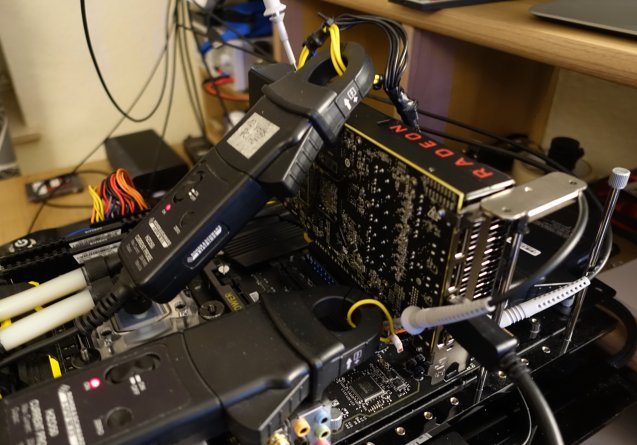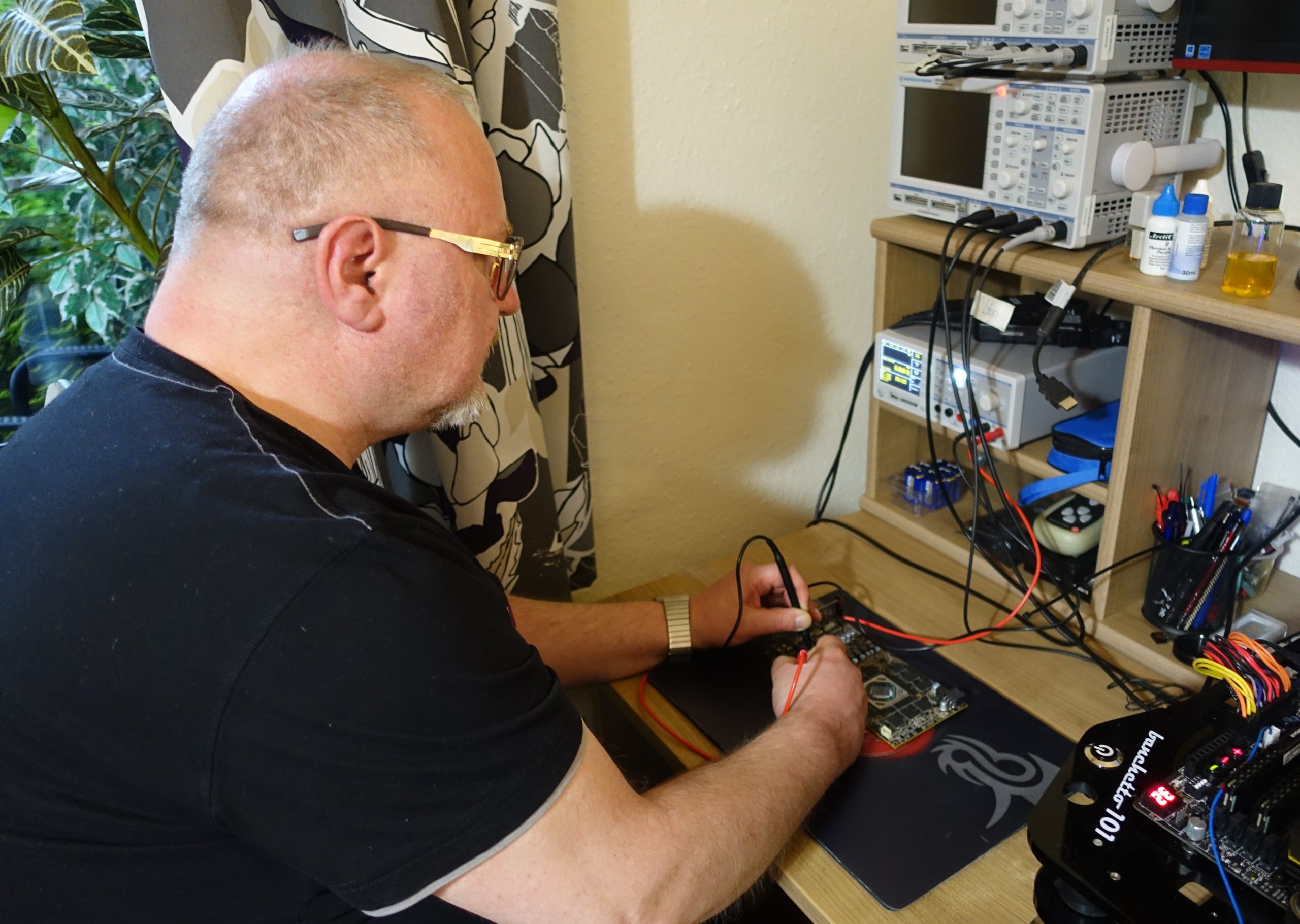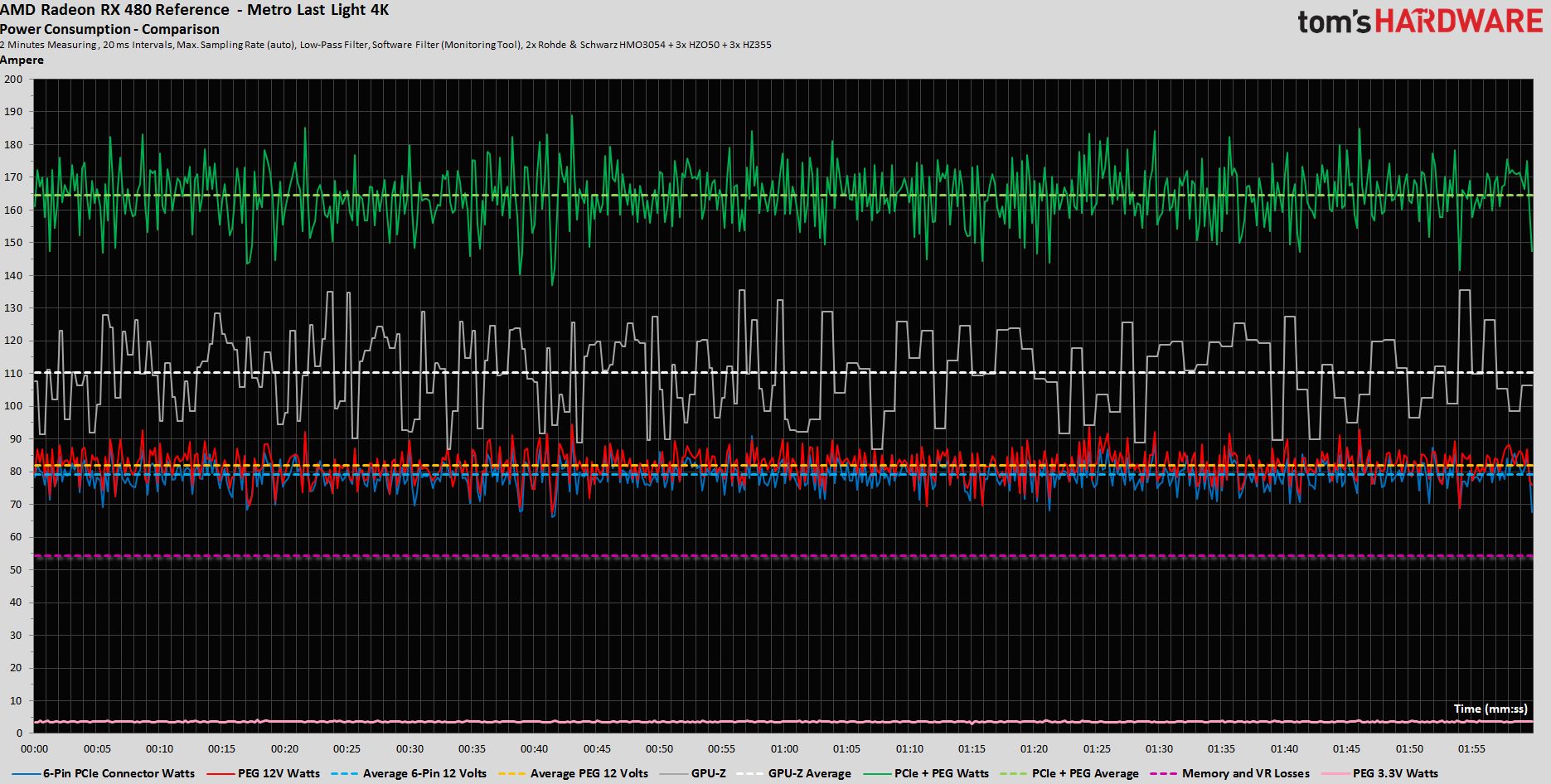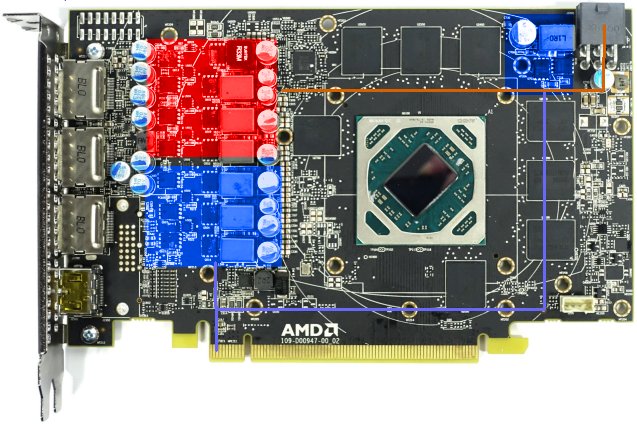AMD Radeon RX 480 Power Measurements Repeated And Clarified
Radeon RX 480 Power Measurements And Possible Causes
[Update: On 7/5/2016, at 2:40 pm PT we updated a few sections on this page to reflect even more precise measurements that tell us that our original review analysis was correct regarding the load distribution across the card's six phases. This further clarity also resulted in removing some of our hypothesis text. We note below the sections we have updated.]
It’s not often that a graphics card launch is as polarizing as AMD’s Radeon RX 480 introduction. Our launch review produced graphs that have been interpreted incorrectly. Further, quotes were taken out of context, causing a great deal of debate. To set the record straight, we performed several follow-up tests, and are explaining the results in more depth.
In the meantime, AMD reacted to the issue through a statement, below, and we are going to comment on it later in the context of our findings.
As you know, we continuously tune our GPUs in order to maximize their performance within their given power envelopes and the speed of the memory interface, which in this case is an unprecedented 8Gbps for GDDR5. Recently, we identified select scenarios where the tuning of some RX 480 boards was not optimal. Fortunately, we can adjust the GPU's tuning via software in order to resolve this issue. We are already testing a driver that implements a fix, and we will provide an update to the community on our progress on Tuesday (July 5, 2016).
Measurement Methodology
Some readers and colleagues have commented on our launch article’s measurements and graphs. They might even have a bit of a point when it comes to the latter, since it’s possible to draw the wrong conclusions without some background knowledge. Note that we’ve posted high-resolution graphs that are only one click away.
However, we use a low-pass filter and the highest sampling rate for our measurements to avoid aliasing effects and noise as much as possible. In addition, we’ve compared our measurement results to those of select graphics cards manufacturers over the years. Some of them use their own boards instead of oscilloscopes, but we’ve always ended up within the measurement error range with our results.
Note: Our power consumption measurement procedure and equipment is described in detail in our reference article on this very topic (The Math Behind GPU Power Consumption And PSUs).
Get Tom's Hardware's best news and in-depth reviews, straight to your inbox.
In order to make things easier for a broader enthusiast audience, we increase the measurement intervals considerably and use new software for the analysis, which is able to evaluate very short load peaks (and valleys) and their timing. This procedure yields a much smoother curve, but it’s also a lot less irritating for readers. It goes without saying that we want to know when true spikes exist. However, that’s a story for another day.
Understanding The Terminology
Much virtual ink has been spilled on the topic of AMD’s Radeon RX 480 exceeding power targets and specifications. Before we can really get into this topic, it’s important to understand that this problem has nothing whatsoever to do with wattage. The only thing that matters is current. Consequently, we’re going over the Radeon RX 480's power supply and phase distribution first.
Without this overview, it’s not possible to make objective sense of the discussion on the specifications.
Replicating the Results
[Updated: 7/5/2016, 2:40 pm PT] A fact we got right in our Radeon RX 480 launch article: the card's six phases are distributed equally between the PCIe slot and the PCIe power connector. At first, we could only guess at the balance between all components, and our second time through we drew the wrong conclusions. This is why we decided to measure the connections of all phases ourselves. Based on this, we've also updated a small portion of the content of our hypothesis to reflect this.
We, and some of our colleagues, initially repeated our measurements because there were many questions about our original results. This time, we lowered the temporal resolution and, in turn, increased the filtering. Overall, our new measurement results come in approximately 1W below the previous ones, which falls within the usual measurement error range.
We performed individual measurements for the PCIe slot on the motherboard and the 12V PCIe power connector, as well as the PCIe slots’ 3.3V line. We also added all three to obtain the full board power.
In addition, we analyzed the GPU-Z log file, which was created in parallel with our other power consumption measurements. GPU-Z provides a raw measure of the GPU’s power consumption.
GPU-Z’s smallest possible measurement intervals are 500 ms, which is considerably longer than our measurement equipment’s. In order to add the GPU-Z results to our Excel chart, we used linear interpolation to create the missing data points. This might not be the most precise solution, but it should get the job done, especially since GPU-Z’s software-based, real-time analysis doesn’t exactly line up with the other measurements’ timeline anyway.
Beyond The 110W GPU
AMD is right when it says that the Radeon RX 480 GPU is a true 110W GPU. The average GPU-Z measurement result comes in exactly at that point. But that's not the whole story. After all, there’s still the rest of the graphics card, including other components that consume power. And then there are power losses as well.
Let’s take a look at the Radeon RX 480 below. We marked how we think the voltage converters are connected to the power supply lines based on our new round of measurements.
According to our measurements (see graph above), there’s a 50W difference between the overall board power at 164W and the separately-logged GPU power at 110W, if the PCIe-slot’s 3.3V connector is taken out of the equation from the start. The million dollar question is where exactly these 50W go.
Memory Power Consumption
The memory is an obvious place for speculation. Unfortunately, we weren’t able to get any exact power consumption numbers from Samsung. The only numbers that we do have are older and for the 4 Gb/s memory modules that consume 4.35W per gigabyte.
[Updated: 7/5/2016, 2:40 pm PT] There have been technological advances in the meantime and, in combination with some unsubstantiated statements, we’re thinking that we must calculate using 20W, or just slightly more.
Power Loss in the Power Converters and Other Components
It’s time to calculate the estimated power consumption for each of the six phases that serve the GPU. Distributing the GPU’s 110W evenly across its six phases leaves us with a power consumption of 18.3W per phase. In addition, there’s the power loss in the power converters, which amounts to 2.2W per phase.
This means that the GPU’s power consumption and the power loss in the power converters add up to approximately 20.5W per phase. These are all just estimates, of course, but we do feel that they’re plausible enough to draw some conclusions.
Distribution Across Power Supply Lines
[Updated: 7/5/2016, 2:40 pm PT] We’ve reached the most important part: the load distribution. Having figured out the distribution of the different loads, we can logically deduce that three of the six phases serving the GPU are connected to the PCIe slot, and three plus a separate phase on the top left are connected to the PCIe power connector. The phase for the memory modules is also connected to the PCIe slot (in the upper right, next to the PCIe connector).
Let's look at what this configuration means for the load distribution across all of the power supply lines:
| Motherboard PCIe Slot | Load | PCIe Power Connector | Load |
|---|---|---|---|
| 3 of 6 Phases with 20.5W each (plus 1 extra at 20) | Approx. 82W (12V) | 3 of 6 Phases with 20.5W each | Approx. 62W |
| 1 Phase with 4W | 4W (3.3V) | 1 Phase with 16W | Approx 16W |
| Total | 86W combined | Total | 78W |
International Rectifier's IR 3567B could distribute the load between the phases asymmetrically instead, of course. But that wouldn’t make any sense, especially in light of the potentially unpredictable consequences and the looming overload of the six-pin PCIe power connector.
[Updated: 7/5/2016, 2:40 pm PT] Conversely, this also means that any other configuration would require an eight-pin PCIe power connector, which is the exact alternative that we said we preferred in our launch article, because it would be technically superior.
In comparing our measurement results with our hypothetical numbers, we find that our model fits both rounds of measurements well. On the next page, we finally take a look at the power consumption measurement results, discuss the supposedly exceeded specifications, and draw our conclusion.
- 1
- 2
Current page: Radeon RX 480 Power Measurements And Possible Causes
Next Page Power Consumption, Specifications And Conclusion
Igor Wallossek wrote a wide variety of hardware articles for Tom's Hardware, with a strong focus on technical analysis and in-depth reviews. His contributions have spanned a broad spectrum of PC components, including GPUs, CPUs, workstations, and PC builds. His insightful articles provide readers with detailed knowledge to make informed decisions in the ever-evolving tech landscape
-
ssdpro "SummaryReply
1. Our modified second round of measurements replicated the results of our first round. The amount of current flowing through the motherboard PCIe slot’s 12V rail exceeds the upper limit of the tolerance range described in the PCI-SIG specifications. Our repeated measurements of the reference card show currents 23 percent above the PCI-SIG norm."
So, the summary was the same. The new article just puts more emphasis on the minimal risks/dangers than the compliance failure itself. Seems like an attempt to please someone, or appease some source of revenue. -
FormatC Reply18227882 said:So, the summary was the same. The new article just puts more emphasis on the minimal risks/dangers than the compliance failure itself. Seems like an attempt to please someone, or appease some source of revenue.
Totally wrong. Not only the summary is the same, the results are also totally similar. And exactly this is the difference to a lot of other re-benches I saw after the launch. I got a lot of feedback about our measuring methods and also had to read a lot of crap and allegations on other sites and forums. This was the reason why I simply does the same: low-res measuring, even more low-pass-filtering and enlarged pictures. Funny: nothing has been significant changed. This few spikes goes mostly in both directions, so you have the same average as cutted or smoothed curves (different choise).
The new article just puts more emphasis on the technical background, possible reasons and the math behind if it's allowed to correct you with my own words :)
The goal was to find the reason for the results and to be honest: my family lost the whole weekend with me and I lost over two days of my lifetime. That means: I does it not for my pleasure but I feel it's only fair to our readers to clarify something. :)
And finally to be accurate: This is only a question of current, the power consumption is secondary. ;) -
Placobravo I wonder if they could simply solve this by a driver update, so that the card could function as any other card (which means taking most of the power from the 6-pin connector rather then the PCI-E).Reply
Anyway at this point it is clear to me that anybody wishing for an rx-480 should wait for aftermarket solution. Brands like Sapphire will definitely solve those issues :) -
frzsk Specifications covering just how much power is allowed to flow through the pins of a 16x PCIe motherboard slot were established a long time ago. However, saying that they include a maximum wattage isn’t just misleading, but flat out false.Reply
The PCI-SIG defines the maximum amperage for the 12V motherboard slot connector as 5.5A, with a maximum tolerance for voltage of plus or minus eight percent (see table below). A quick multiplication of this number by 12V yields either the reference point of 66W, or the maximum of 71W that includes the eight percent.
EDIT:
You say in the first paragraph that there's no max wattage but in the 2nd paragraph you say that there is one. -
FormatC Reply18228013 said:I wonder if they could simply solve this by a driver update, so that the card could function as any other card (which means taking most of the power from the 6-pin connector rather then the PCI-E).
Anyway at this point it is clear to me that anybody wishing for an rx-480 should wait for aftermarket solution. Brands like Sapphire will definitely solve those issues :)
The protocoll, used by their PWM controller allows a re-balancing and it is in theory also possible to supply the whole card with only two of this oversized phases :)
I'm sure they will move a little bit more load to the 6-pin PCIe, beacuse he is completely connected. My own tests showed that they will survive 300 watts and more without damage.
18228022 said:Specifications covering just how much power is allowed to flow through the pins of a 16x PCIe motherboard slot were established a long time ago. However, saying that they include a maximum wattage isn’t just misleading, but flat out false.
This is exactly what I wrote on top of page Two. Only the current is interesting, the voltage is within the ATX specs and a completely other story. The translation from German is not clear enough - in original I wrote, that this wattage product is used from the masses to simplify the problem but it is totally unusual ;)
I wrote this also to our editor-in-chief and hope that he can fix it asap. Thx for finding. ;)
-
JRHERITA This is bad - because over time that 23% spec will be harder and harder on the motherboard components. A chip that runs hotter consumes more power -- and an older GPU will certainly run hotter due to a less than perfectly clean case/GPU fan setup, the transistors aging (perhaps needing more voltage to work causing power to go up). On top of this, the motherboard connectors don't stay pristine forever, nor do the motherboard power circuits or even the power supply. Being overspec may work OK now, but in a few years, that's not so certain.Reply -
gorgamin A real Electrical Engineer has answered some of the myths reviewers have been propagating. I think most of these reviewers need to go back to EE school (incl. Tomshardware) as they don't seem to grasp what they're saying.Reply
There is nothing wrong with the RX480
https://www.reddit.com/r/Amd/comments/4rbw8p/facts_about_pcie_connectors/ -
cilliers Tomshardware very seldom replicates experiments for the same product, so therefore this article looks really out of place. As I was reading this second article , I couldn't help imagining an angry AMD marketing man on the phone with the TH editor, demanding at least a second round of tests with a newly shipped card. This is so funny, especially the 6 points listed for clarification in the summary. By the way. "Assumptions" to an experiment always go in the paragraph about the experiment design, not at the back...FYI. This is just too funny. Thank you TH.Reply -
octavecode Most GPU makers will just replace the 6pin with 8pin connector and maybe add a couple of phases or reroute them.Reply -
FormatC Reply
Ok, so the PCIE-SIG is wrong and a nursery... As I wrote: to be comparable to (older) hardware. Send this engineers's comedy to someone from the SI business, he will hit you :D18228079 said:A real Electrical Engineer...
Tomshardware very seldom replicates experiments for the same product, so therefore this article looks really out of place.
Also wrong. They very seldom translated my content from German. To be honest: AMD is not paying for my pleasure or some sexual services. :D
Also funny: yesterday I was totally Nvidia-biased, today I'm AMD biased. So what? :P



